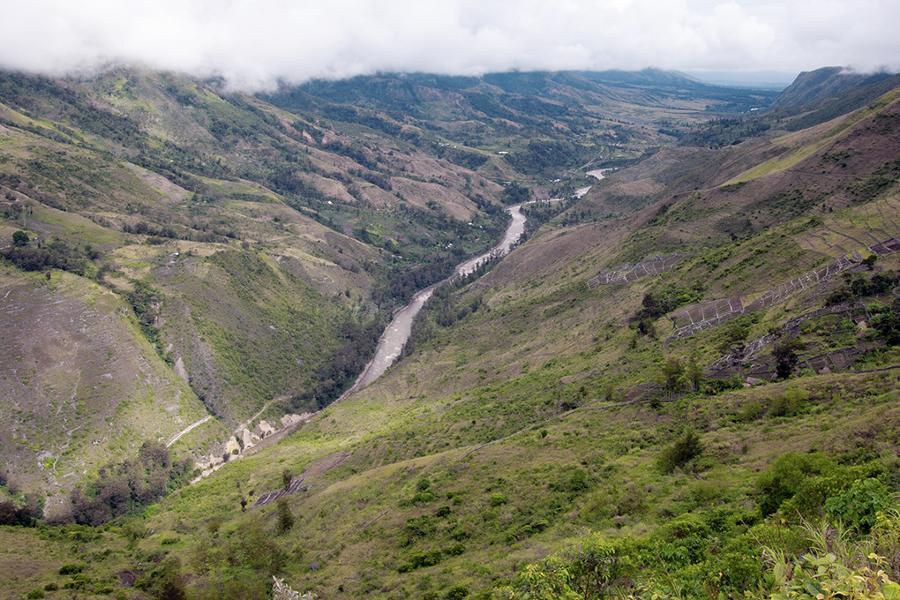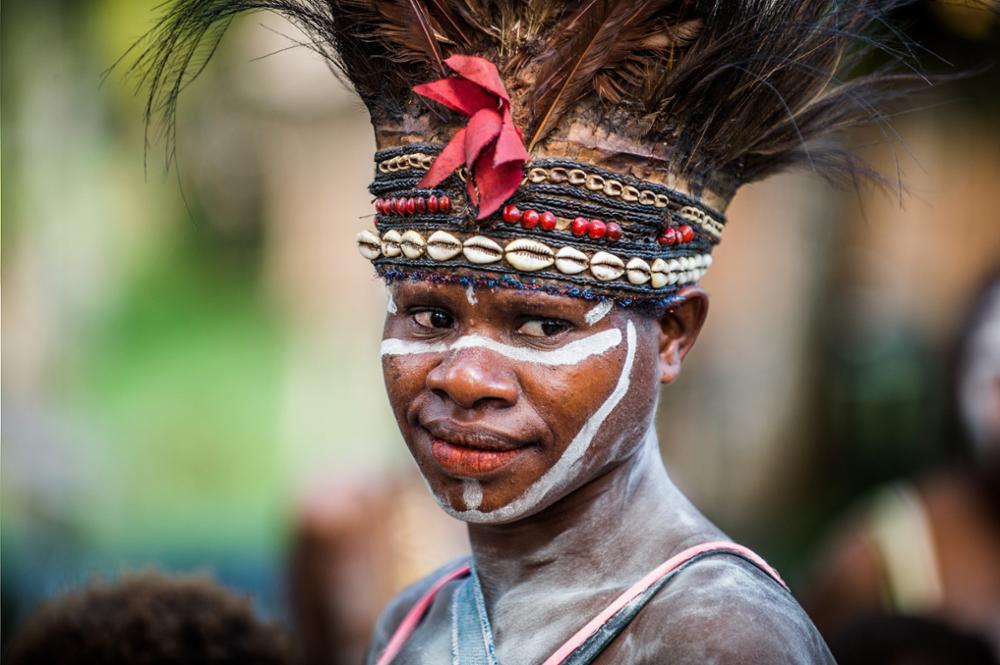
Meeting the Papuans in the Baliem Valley
It is possible to have your breath taken away by a landscape, right there - right on your doorstep. Whether you live by the sea, on the slopes of a mountain or even in the heart of a megalopolis. To continue to discover, to live an adventure where we have set down our bags for many years. This is certainly the beauty of the world, its capacity to provide and renew wonder in everyday life.
However, this search for the unknown, this change of scenery, can also be provoked head-on; confront it by seeking and encountering a radically new world. Of course, this requires traveling, perhaps taking a plane. The (climatic) consequences induced by this mode of transport are known to everyone today; thus travel, which paradoxically is a catalyst for encounters and sharing, also remains, first and foremost, a selfish pleasure; in a way a credit on the future world. But travel is much more than just moving; then it is also a therapy for all ills and does not setting an example at all levels lead to a deadly asceticism?
However, that is not our topic today. In this post, it is therefore a question of travel, and particularly of a journey. One of those whose possibility amazed us when we were children exploring the atlases. Especially since it is an island, in the Southern Hemisphere, on the margins of the Indian and Pacific Oceans and its inhabitants crystallize a powerful imagination. And then Corto Maltese ventured there in “The Ballad of the Salt Sea”, so what better viaticum?
What is found in New Guinea
But let's try to be precise: this is therefore New Guinea. Singularly, men (Europeans, etc.) drew – decided – a border, dividing the island into two political entities; geometric heritage of past colonial empires. The West, in the Dutch fold, was then integrated into the vast Indonesian whole, the East – German and British – became independent under the name of Papua New Guinea.
“One Island, one Country”, I remember this graffiti on the walls of Dublin in the last century, it had an impact on me and seemed to take on its full meaning. I imagine that this dream of unity is also shared by some in New Guinea, however, we must be aware of the heterogeneity of this territory. The third largest island on the world map, the region concentrates the greatest linguistic diversity in the world: there are hundreds of idioms. Impenetrable mangroves, steep valleys, high ridge lines, the topography has limited exchanges, allowing entities to live and develop in isolation. So a trip to New Guinea therefore consists of agreeing to have a fragmented vision of the island.
Set out to conquer the Baliem valley
At our level, the choice therefore fell on the Baliem valley. In the center of the island, on Indonesian territory, it remains relatively easy to access. From Jayapura, the large coastal town and bridgehead of Indonesian presence (colonization?), it is possible to take an ATR flight to Wamena. Wamena; it is a sort of Far-West town, recent and without history, a place of convergence of inhabitants of the upper valleys of the Dani ethnic group. Rough streets laid out at right angles lead to the nerve center of the city, the covered market which is held there daily. It is a large bazaar where exotic fruits, market garden products, Chinese trinkets, Papuan crafts and wandering pigs mingle. The ground is streaked with the red spit of betel consumers, a skinned dog carcass awaits its cutting on a butcher's stall, chickens wander among young people who sniff glue, failing to drink alcohol, the sale of which is banished from the city.
Wamena, the obligatory passage
Wamena is an economic zone, a point of attraction for Papuans: it defines the dichotomy of this territory which hesitates between age-old traditions and modernism, which also aspires to change. It is not for her that we went to Papua, nevertheless, it is a place of obligatory passage, a gateway; a paradigm of these emerging countries and changing societies.
The attraction of Wamena therefore lies in its airport which allows you to land in the very heart of New Guinea, in a basin surrounded by mountains. A few kilometers in an old jeep and the road ends at a bridge washed away by a flood; some trunks are thrown away and you will have to cross on foot the vast bed of a stream flowing into the Baliem, which, moreover, allows you to imagine the power of the water which must rush down the mountain on certain occasions.
First meeting with the Papuans
Beyond this bridge, cell phone networks are no longer accessible, there are no more shops, no more possibility of getting bottled water. If the objective is only to make a quick one-day foray into the valley, then you can certainly do without the help of a guide. However, for several days, this seems essential to us. The guide will perfectly master the itineraries which he will be able to adapt to your abilities, will be the interpreter between you and the Papuans you meet, will have the knowledge networks to sleep in the villages, will organize stewardship with his cook and his porters (provisions, kitchen utensils - essential for boiling water - possibly tents). Putting porters to work also provides a source of income for these families. Because we must clearly see that the Papuans in the villages live outside the economic system as we understand it. In the mountains, they are all farmers and self-sufficient, the land is fertile and generous, it provides food, however this system does not provide any monetary compensation. Thus, buying a handicraft item, having a team work with a guide, will allow locals to earn a little money which will be spent in Wamena to buy small objects that improve daily life.
Sometimes it doesn't take much to be happy and walking in a majestic place goes a long way. The paths which progress along the curve lines offer the advantage of limiting the differences in altitude; you can progress for a few kilometers, perpendicular to the slope, before encountering a break or steep slope. Caressed by the breeze, in a virgin universe where plants and minerals stand out against a sky with different variations, the mind wanders without constraint. We cross a ravine and a new perspective opens up, revealing a hidden mountain section where a powerful torrent rushes down.
And then, at the bend in the path, we come face to face with an old Papuan who is going about some daily tasks. He is naked, just a penis sheath and a feather crown; he did not prepare to receive tourists; he is right there, as usual, like his father and his grandfather and all his ancestors were before him long before the arrival of the settlers. On the hand he extends to greet us, we see severed phalanges: severed by a stone hatchet, these mutilations accompanied his mourning. We then realize that within a few years, a generation, this will have disappeared. Christian missions, Java civil servants on the front lines, schooling, the presence of tourists, all of this is gradually eroding a foundation that is, however, thousands of years old. This is how the world goes. There will then only be folklore left and you will have to go deeper into the island, into still unexplored lands, borrow a Pilatus plane to land on a short runway on a high plateau.
In any case, today, the mountain still remains populated and the valley offers numerous villages to be seen scattered along its slopes. When we approach one of them, we see that the mountain is completely shaped. Upstream and downstream of the village, there are plots carefully circumscribed by dry stone walls; some constitute pig enclosures (the possession of which confers power and wealth), others present rows of vegetables drawn with a line. Here and there, we observe retaining walls and stepped terraces; for generations, the land has been worked and modeled. Almost everywhere today, we find a small church of the evangelical missions, however, before these modern markers, it must have been difficult to identify the villages on the slopes of the mountain. The Dani habitat is made of small circular plant huts. You enter through a small door that almost requires you to crawl. The hut is divided into two levels, but the cramped conditions do not allow you to stand up, you have to crouch. Upstairs is the sleeping area, accessed by a small ladder. On the ground floor and in the center, there is always a fireplace. As there is no chimney, everything is covered with tallow, and the ceiling and walls have taken on a black tint; the lack of windows also gives a strange feeling. The living space is symbolically charged, men and women do not live together, and on the contrary, women are prohibited from entering the men's space where magical objects are kept, a still-present legacy of ancient cults. A concession to modern times and the result of campaigns by Indonesian governments, small solar panels attached to the top of long poles provide a little lighting.
Trek in the Baliem Valley
The first stage of our trek took us to Kelice. The view of the valley from this location is simply magnificent.
The day before, a pig had fallen and broken a leg, slaughtered the very morning of our arrival and offered by its owner to the entire village, we were able to see its preparation. A vast hole is lined with foliage, burning stones are placed in successive layers, the pig, tarot tubers, etc. All this is still covered with foliage, stones, etc. This gives a particular cooking, the meat does not It is neither grilled nor boiled.
The second night we spent in Sokyosimo. The village is lower, on the edge of the river, but free of malaria like the entire valley, the altitude being too high for the anopheles. To get there, we had to cross rivers on suspension bridges. Sokyosimo is bigger than Kelice, there is a school, an infirmary, a church. Peace and serenity emanate from this place. Green lawn terraces worthy of a golf green, palm trees providing shade. Comfort for the hiker after a long day of walking, it is also possible to swim in the icy water of the river.
The third night in the valley we spent in Ergem. It is a village perched on the hillside, every piece of land is cultivated, and the image that emerges is that of market gardening abundance. This also indicates a lot about the Papuan way of life which revolves around agricultural activities. In this regard, this brings us face to face with our Western paradoxes. If the Papuans have no money, on the other hand, they all farm in a completely ecological way, they are not obese and all seem in good physical shape, the result of a life in the open air and manual work. For their part, Westerners work to have money, to buy organic products and to go to the gym. Who are the most consistent?
Indeed, the trip to New Guinea is necessarily a journey of discovery, but like all good trips, it also gives rise to introspection; this is also its great wealth and what leads us to affirm that this trip to Papua is unique, that it truly constitutes a wonderful experience... A light bag, a rain cape, good walking shoes, you don't need little more for adventure to be offered to us.
Written by Mr Ludovic WILHELM
To go further and you also discover the Baliem valley, we invite you to discover the circuit
https://www.voyageindonesie.com/circuit/papouasie-tribus-dani-vallee-baliem


